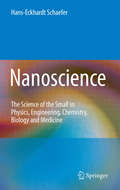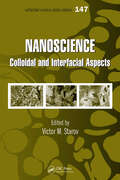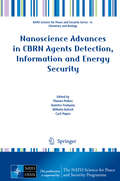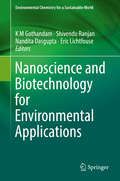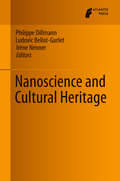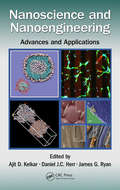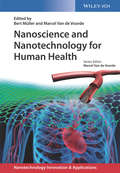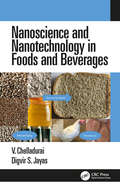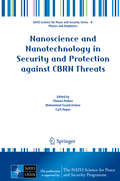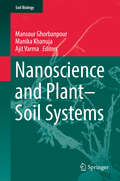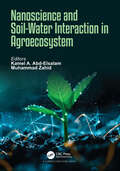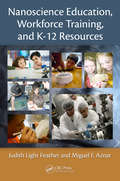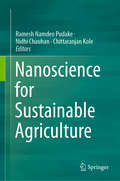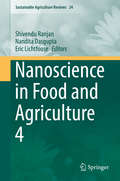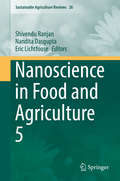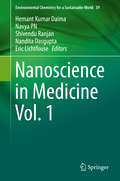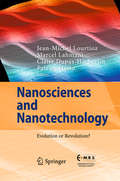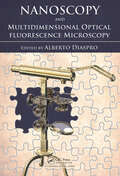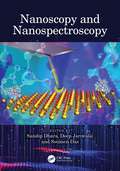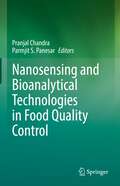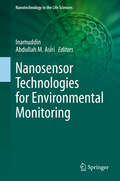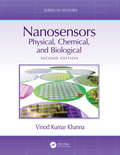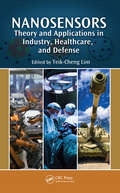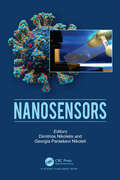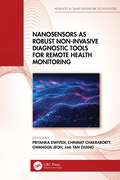- Table View
- List View
Nanoscience
by Hans-Eckhardt SchaeferNanoscience stands out for its interdisciplinarity. Barriers between disciplines disappear and the fields tend to converge at the very smallest scale, where basic principles and tools are universal. Novel properties are inherent to nanosized systems due to quantum effects and a reduction in dimensionality: nanoscience is likely to continue to revolutionize many areas of human activity, such as materials science, nanoelectronics, information processing, biotechnology and medicine. This textbook spans all fields of nanoscience, covering its basics and broad applications. After an introduction to the physical and chemical principles of nanoscience, coverage moves on to the adjacent fields of microscopy, nanoanalysis, synthesis, nanocrystals, nanowires, nanolayers, carbon nanostructures, bulk nanomaterials, nanomechanics, nanophotonics, nanofluidics, nanomagnetism, nanotechnology for computers, nanochemistry, nanobiology, and nanomedicine. Consequently, this broad yet unified coverage addresses research in academia and industry across the natural scientists. Didactically structured and replete with hundreds of illustrations, the textbook is aimed primarily at graduate and advanced-undergraduate students of natural sciences and medicine, and their lecturers.
Nanoscience: Colloidal and Interfacial Aspects (Surfactant Science)
by Victor M. StarovBringing together a prominent roster of 42 leading investigators and their teams, this volume details the wide range of theoretical and experimental knowledge that can be successfully applied for investigating nanosystems. The book provides researchers with a full examination of nano-disperse colloids, homogeneous and heterogeneous nano-structured materials (and their properties), and shelf-organization at the nano-scale. It explores non-linear lectrokinetic phenomena in nano-sized dispersions and nano-sized biological systems. It discusses application aspects of technological processes in great detail, offering scientists and engineers across all fields authoritative commentary on colloid and interface science operating at the nanoscale.
Nanoscience Advances in CBRN Agents Detection, Information and Energy Security
by Plamen Petkov Dumitru Tsiulyanu Wilhelm Kulisch Cyril PopovThe preparation and characterization of various nano-scaled materials and their applications in diverse security and safety- related fields. Readers are provided with a broad overview on the topic as it combines articles addressing the preparation and characterization of different nano-scaled materials (metals, oxides, glasses, polymers, carbon-based, etc. ). The contributions derive from the lectures and contributions of the NATO Advanced Study Institute meeting "Nanoscience Advances in CBRN Agents Detection, Information and Energy Security" held in Sozopol, Bulgaria, 29 May - 6 June, 2014. In addition, it presents an interdisciplinary approach, utilizing Nanoscience and Nanotechnology research from different disciplines including; physics, chemistry, engineering, materials science and biology. A major advantage of this book, which represents the knowledge of experts from 20 countries, is the combination of longer papers introducing the basic knowledge on a certain topic, and brief contributions highlighting specific applications in different security areas.
Nanoscience and Biotechnology for Environmental Applications (Environmental Chemistry for a Sustainable World #22)
by K M Gothandam Shivendu Ranjan Nandita Dasgupta Eric LichtfouseThis book presents the complete guide for readers to understand the applications, and pros and cons of nanotechnology applications in environmental remediation, although there are few critical reviews and textbooks available on environmental biotechnology. Water pollution has become one of the biggest concerns of the world. After the industrialisation and urbanisation, environmental pollution has become an enormous concern. Water pollution results in biomagnifications by entering the food chain. As a result water pollution and its risks need to be considered seriously and solutions need to be researched. This volume looks into such topics as bioremediation, nanobiotechnology, biosensors, and enzyme degradation to find solutions to these problems.
Nanoscience and Cultural Heritage
by Philippe Dillmann Ludovic Bellot-Gurlet Irène NennerThis book aims to give state of the art in several domains of cultural heritage in which Nanosciences allow fundamental breakthrough. The first part of the book concerns nanostructured materials in ancient artifacts. Understanding their nature and formation processes bring new insight in the apprehension of technical level of ancient societies but can also inspire the design of new materials. The second part is dedicated to the understanding of materials. This crucial issue in material science today, for cultural heritage, needs to perform specific characterization techniques and technologies, but also to create tailored analytical strategies. Part three presents new methods, processes and materials at nano levels that can bring innovative solutions to conservation and restoration issues, linked with the understanding of the alteration processes involved at different scales.
Nanoscience and Nanoengineering: Advances and Applications
by Ajit D. Kelkar Daniel J.C. Herr James G. RyanReflecting the breadth of the field from research to manufacturing, Nanoscience and Nanoengineering: Advances and Applications delivers an in-depth survey of emerging, high-impact nanotechnologies. Written by a multidisciplinary team of scientists and engineers and edited by prestigious faculty of the Joint School of Nanoscience and Nanoengineering
Nanoscience and Nanotechnology for Human Health
by Bert Müller Marcel Van de VoordeUnique in combining the expertise of practitioners from university hospitals and that of academic researchers, this timely monograph presents selected topics catering specifically to the needs and interests of natural scientists and engineers as well as physicians who are concerned with developing nanotechnology-based treatments to improve human health. To this end, the book cover the materials aspects of nanomedicine, such as the hierarchical structure of biological materials, the imaging of hard and soft tissues and, in particular, concrete examples of nanotechnology-based approaches in modern medical treatments. The whole is rounded off by a discussion of the opportunities and risks of using nanotechnology and nanomaterials in medicine, backed by case studies taken from real life.
Nanoscience and Nanotechnology in Foods and Beverages
by Vellaichamy Chelladurai Digvir S. JayasPotential applications of nanotechnology in food industry include: encapsulation and delivery of substances in targeted sites, increasing flavor, introducing antibacterial nanoparticles into food, enhancing shelf life, sensing contamination, improved food storage, tracking, tracing, and brand protection. This book provides a basic understanding of the nanoscience and nanotechnology and their applications to different food industry sectors, covering both benefits and drawbacks using nanotechnology in food processing and discussing the development of an international regulatory framework.
Nanoscience and Nanotechnology in Security and Protection against CBRN Threats (NATO Science for Peace and Security Series B: Physics and Biophysics)
by Plamen Petkov Mohammed Essaid Achour Cyril PopovThis book is based on the lectures and contributions of the NATO Advanced Study Institute on “Nanoscience and Nanotechnology in Security and Protection Against CBRN Threats” held in Sozopol, Bulgaria, September 2019. It gives a broad overview on this topic as it combines articles addressing the preparation and characterization of different nanoscaled materials (metals, oxides, glasses, polymers, carbon-based, etc.) in the form of nanowires, nanoparticles, nanocomposites, nanodots, thin films, etc. and contributions on their applications in diverse security and safety related fields. In addition, it presents an interdisciplinary approach drawing on the Nanoscience and Nanotechnology know-how of authors from Physics, Chemistry, Engineering, Materials Science and Biology. A further plus-point of the book, which represents the knowledge of experts from over 20 countries, is the combination of longer papers introducing the background on a certain topic, and brief contributions highlighting specific applications in different security areas.
Nanoscience and Plant–Soil Systems
by Ajit Varma Khanuja Manika Mansour GhorbanpourThis book provides in-depth reviews of the effects of nanoparticles on the soil environment, their interactions with plants and also their potential applications as nanofertilizers and pesticides. It offers insights into the current trends and future prospects of nanotechnology, including the benefits and risks and the impact on agriculture and soil ecosystems. Individual chapters explore topics such as nanoparticle biosynthesis, engineered nanomaterials, the use of nanoclays for remediation of polluted sites, nanomaterials in water desalination, their effect on seed germination, plant growth, and nutrient transformations in soil, as well as the use of earthworms as bioremediating agents for nanoparticles. It is a valuable resource for researchers in academia and industry working in the field of agriculture, crop protection, plant sciences, applied microbiology, soil biology and environmental sciences.
Nanoscience and Soil-Water Interaction in Agroecosystem
by Kamel A. Abd-Elsalam Muhammad ZahidThis book discusses how important nanotechnology is for increasing agricultural production through better management of the soil and water. The book looks at how soil characteristics, water retention, and nutrient availability may all be improved by nanoparticles. It draws attention to the use of nanoparticles in precision agriculture as well as their potential for cleaning up polluted soils. The book provides creative answers to problems like water shortages and soil degradation by fusing nanoscience with conventional methods, eventually advancing sustainable farming methods. The significance of nanotechnology in building resilient agroecosystems for future food security is highlighted by this interdisciplinary approach.
Nanoscience Education, Workforce Training, and K-12 Resources
by Judith Light Feather Miquel F. AznarThe nanotech revolution waits for no man, woman…or child. To revitalize science, technology, engineering, and mathematics (STEM) performance, the U.S. educational system requires a practical strategy to better educate students about nanoscale science and engineering research. This is particularly important in grades K–12, the effective gestation point for future ideas and information. Optimize your use of free resources from the National Science Foundation The first book of its kind, Nanoscience Education, Workforce Training, and K–12 Resources promotes nano-awareness in both the public and private sectors, presenting an overview of the current obstacles that must be overcome within the complex U.S. educational system before any reform is possible. It’s a race against time—and other countries—and the fear is that U.S. students could lag behind for decades, with ineffective teaching and learning methods handicapping their ability to compete globally. Focusing on the application of new knowledge, this concise and highly readable book explores the transdisciplinary nature of nanoscience and its societal impact, also addressing workforce training and risk management. Illustrating the historical perspective of the complexity of K–12 education communities, it defines nanotechnology and evaluates pertinent global and national landscapes, presenting examples of successful change within them. This book is composed of four sections:Foundations—addresses the national educational matrix, exploring the scientific and social implications associated with the delay in adopting nanoscience education in public schoolsTeaching Nanotechnology—discusses the critical process of teaching K–12 students the skills to understand and evaluate emerging technologies they will encounterNanoscience Resources and Programs—provides a wide overview of the resources offered by funded outreach programs from universities with nanoscience centersFramework Applied—analyzes the structure of national government programs and skill level recommendations for nanoeducation from the National Nanotechnology InitiativesThis book offers plans of action and links to sustainable (largely free) development tools to help K–12 students acquire the skills to understand and evaluate emerging technologies. Promoting a holistic teaching approach that encompasses all aspects of science, the authors strive to help readers implement change so that decisions about resources and learning are no longer made "from the top down" by policymakers, but rather "from the bottom up" by teachers, parents, and students at the local level.Akhlesh Lakhtakia, one of the contributors to this volume, was recently featured on CNN in a discussion on solar energy.
Nanoscience for Sustainable Agriculture
by Ramesh Namdeo Pudake Nidhi Chauhan Chittaranjan KoleThis book discusses the ability of nanomaterials to protect crop-plant and animal health, increase production, and enhance the quality of food and other agricultural products. It explores the use of targeted delivery and slow- release agrochemicals to reduce the damage to non-target organisms and the quantity released into the soil and water, as well as nanotechnology-derived tools in the field of plant and animal genetic improvement. It also addresses future applications of nanotechnology in sustainable agriculture and the legislative regulation and safety evaluation of nanomaterials. The book highlights the recent advances made in nanotechnology and its contribution towards an eco-friendly approach in agriculture.
Nanoscience in Food and Agriculture 4
by Shivendu Ranjan Nandita Dasgupta Eric LichtfouseIn this book we present ten chapters describing the synthesis and application of nanomaterials for health, food, agriculture and bioremediation. Nanomaterials, with unique properties are now being used to improve food and agricultural production. Research on nanomaterials is indeed revealing new applications that were once thought to be imaginary. Specifically, applications lead to higher crop productivity with nanofertilisers, better packaging, longer food shelf life and better sensing of aromas and contaminants. these applications are needed in particular in poor countries where food is scarce and the water quality bad. Nanotechnology also addresses the age old issue of water polluted by industrial, urban and agricultural pollutants. For instance, research produces nanomaterials that clean water more efficiently than classical methods, thus yielding water for drinking and irrigation. However, some nanomaterials have been found to be toxic. Therefore, nanomaterials should be engineered to be safe for the environment.
Nanoscience in Food and Agriculture 5
by Shivendu Ranjan Nandita Dasgupta Eric LichtfouseThis book presents comprehensive reviews on the principles, design and applications of nanomaterials in the food and agriculture sectors. This book is the fifth of several volumes on Nanoscience in Food and Agriculture, published in the series Sustainable Agriculture Reviews.
Nanoscience in Medicine Vol. 1 (Environmental Chemistry for a Sustainable World #39)
by Eric Lichtfouse Shivendu Ranjan Nandita Dasgupta Hemant Kumar Daima Navya PnThis book takes a systematic approach to address the gaps relating to nanomedicine and bring together fragmented knowledge on the advances on nanomaterials and their biomedical applicability. In particular, it demonstrates an exclusive compilation of state of the art research with a focus on fundamental concepts, current trends, limitations, and future directions of nanomedicine.
Nanosciences and Nanotechnology
by Jean-Michel Lourtioz Marcel Lahmani Claire Dupas-Haeberlin Patrice HestoThis book provides information to the state of art of research in nanotechnology and nano medicine and risks of nano technology. It covers an interdisciplinary and very wide scope of the latest fundamental research status and industrial applications of nano technologies ranging from nano physics, nano chemistry to biotechnology and toxicology. It provides information to last legislation of nano usage and potential social impact too. The book contains also a reference list of major European research centers and associated universities offering licences and master of nano matter. For clarity and attractivity, the book has many illustrations and specific inserts to complete the understanding of the scientific texts.
Nanoscopy and Multidimensional Optical Fluorescence Microscopy
by Alberto Diaspro"Alberto Diaspro has been choreographing light's dance for over 20 years, and in Nanoscopy and Multidimensional Optical Fluorescence Microscopy, he has assembled a diverse group of experts to explain the methods they use to coax light to reveal biology's secrets."- From the Foreword by Daniel Evanko, editor, Nature Methods Nanoscopy and Multidimens
Nanoscopy and Nanospectroscopy
by Sandip Dhara Deep Jariwala Soumen DasThis book builds a narrative on the near-field optical and spectroscopic studies with an emphasis on plasmonic- and photonic-assisted nano-optics as a tool for superlensing. Deliberations on near-field studies using confined light in various applications are included along with their commercial implications. Single-molecule detection utilizing efficient surface-enhanced Raman scattering phenomenon in the far-field and plasmonic tip-enhanced Raman scattering studies in the near-field measurements for fast analysis up to trace level is discussed. Features: Covers the broad area of nano-optical spectroscopy from the perspective of putting the concepts and innovations in the field to use. Discusses entire spectra of near-field optics and spectroscopy using light. Explores gas/chemical sensing using surface plasmon resonance (SPR) in the Kretschmann configuration. Includes dielectric nano-photonics and optical confinement. Studies phonon behaviour using confined light for the analysis of chemical, biological, and other materials. This book is aimed at graduate students and researchers in material science, analytical chemistry, nanotechnology, and electrical engineering.
Nanosensing and Bioanalytical Technologies in Food Quality Control
by Pranjal Chandra Parmjit S. PanesarThis book reviews applications of nanomaterial and nanodevices in the food industry. It also discusses the advanced bioanalytical techniques, including Enzyme-Linked Immunosorbent Assay (ELISA), immunoanalytical techniques, monoclonal antibody-based immunological techniques for detecting food adulterations and allergens. It comprehensively covers electrode modification and nano-engineered fabrication of biosensors to enhance their functionalities for utilization in food industries. The book highlights the utilization of nanobiosensors for food safety and quality analysis, such as detection of toxin, food-borne pathogen, allergen, and evaluation of toxicity. Further, it also summarizes the recent advances in nanodevices such as nano-systems, nano-emulsions, nanopesticide, nanocapsule and their applications in the food industry. Lastly, it covers nanomaterial-based sensors for drug analysis in diverse matrices. It serves as an invaluable source of information for professionals, researchers, academicians, and students related to food science and technology.
Nanosensor Technologies for Environmental Monitoring (Nanotechnology in the Life Sciences)
by Inamuddin Abdullah M. AsiriAdvanced materials and nanotechnology is a promising, emerging field involving the use of nanoparticles to facilitate the detection of various physical and chemical parameters, including temperature, humidity, pH, metal ion, anion, small organic or inorganic molecules, gases, and biomolecules responsible for environmental issues that can lead to diseases like cancer, diabetes, osteoarthritis, bacterial infections, and brain, retinal, and cardiovascular diseases. By monitoring environmental samples and detecting these environmental issues, advanced nanotechnology in this type of sensory technology is able to improve daily quality of life. Although these sensors are commercially available for the detection of monovalent cations, anions, gases, volatile organic molecules, heavy metal ions, and toxic metal ions, many existing models require significant power and lack advanced technology for more quality selectivity and sensitivity. There is room in these sensors to optimize their selectivity, reversibility, on/off ratio, response time, and their environmental stability in real-world operating conditions. This book explores the methods for the development and design of environmentally-friendly, simple, reliable, and cost effective electrochemical nanosensors using powerful nanostructured materials. More specifically, it highlights the use of various electrochemical-based biosensor sensors involved in the detection of monovalent cations, anions, gases, volatile organic molecules, heavy metal ions, and toxic metal ions, with the ultimate goal of seeing these technologies reach market.
Nanosensors: Physical, Chemical, and Biological (Series in Sensors)
by Vinod Kumar KhannaNanosensors are innovative devices that exploit the unique properties exhibited by matter at the nanoscale. A growing and exciting field, nanosensors have recently spurred considerable research endeavors across the globe, driving a need for the development of new device concepts and engineering nanostructured materials with controlled properties. Nanosensors: Physical, Chemical, and Biological, Second Edition offers a panoramic view of the field and related nanotechnologies with extraordinary clarity and depth. Presenting an interdisciplinary approach, blending physics, chemistry and biology, this new edition is broad in scope and organised into six parts; beginning with the fundamentals before moving onto nanomaterials and nanofabrication technologies in the second part. The third and fourth parts provide a critical appraisal of physical nanosensors, and explore the chemical and biological categories of nanosensors. The fifth part sheds light on the emerging applications of nanosensors in the sectors of society, industry, and defense and details the cutting-edge applications of state-of-the-art nanosensors in environmental science, food technology, medical diagnostics, and biotechnology. The final part addresses self-powering and networking issues of nanosensors, and provides glimpses of future trends. This is an ideal reference for researchers and industry professionals engaged in the frontier areas of material science and semiconductor fabrication as well as graduate students in physics and engineering pursuing electrical engineering and electronics courses with a focus on nanoscience and nanotechnology. Key features: Provides an updated, all-encompassing exploration of contemporary nanosensors and highlights the exclusive nanoscale properties on which nanosensors are designed. Presents an accessible approach with a question-and-answer format to allow an easy grasp of the intricacies involved in the complex working mechanisms of devices. Contains clear, illustrative diagrams enabling the visualization of nanosensor operations, along with worked examples, end of chapter questions, and exhaustive up-to-date bibliographies appended to each chapter.
Nanosensors: Theory and Applications in Industry, Healthcare and Defense
by Teik-Cheng LimNanosensors are rapidly becoming a technology of choice across diverse fields. They offer effective and affordable options for detecting and measuring chemical and physical properties in difficult-to-reach biological and industrial systems operating at the nanoscale. However, with nanosensor development occurring in so many fields, it has become di
Nanosensors
by Dimitrios Nikolelis Georgia Paraskevi NikoleliNanotechnology and biosensors show how nanotechnology is used to create affordable, mass-produced, portable, small-sized nanosensors to directly monitor food toxicants and environmental pollutants. In addition, it provides the market with systems for applications in food analysis, environmental monitoring and health diagnostics. Nanotechnology has led to a dramatic improvement in the performance, sensitivity and selectivity of biosensor devices. Metal-oxides and carbon nanostructures, gold and magnetite nanoparticles, and the integration of dendrimers in biosensors using nanotechnology, have contributed greatly to making nanosensors more effective and affordable in the market. This book provides a timely resource on the subject.
Nanosensors as Robust Non-Invasive Diagnostic Tools for Remote Health Monitoring (Advances in Smart Healthcare Technologies)
by Priyanka Dwivedi Chinmay Chakraborty Gwanggil Jeon Yan ZhangThis book addresses advancement in nanomaterials to design and develop non-invasive healthcare sensors including a combination of hybrid nanocomposites to design non-invasive devices for diagnosing human diseases. The cost-effectiveness is addressed with the methodologies to increase the scalability of the fabrication process. It aims to provide a complete end-to-end solution for smart non-invasive diagnosis developed indigenously and is a cost-effective complete guide to implement a deployable healthcare solution in real-time scenarios.Key Features: Focuses on the design and development of healthcare sensor devices. Reviews different AI techniques using senors for healthcare. Focuses on the application of nanomaterials in different biosensing applications. Explores non-invasive and painless diagnosis with remote healthcare. Discusses remote healthcare with IoMT integration and smart app communication. This book is aimed at graduate students and researchers in biomedical engineering, medical devices, machine learning/pattern recognition, and nanotechnology.
